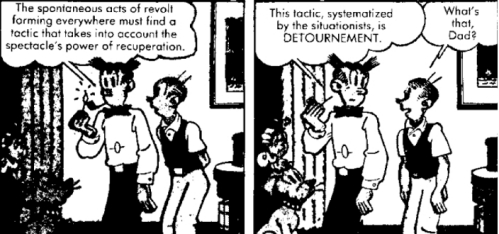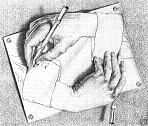Détournement - turning around i.e. "detournement of preexisting aesthetic elements."
"Détournement is thus first of all a negation of the value of the previous organization of expression"

The practice of Détournement involes the capturing of various spectacular images and turning them around in a new presentation in order to subvert the authority of the sign and the significations it sets in order. Détournement was the practice of the International Situationist movement in post-war France and northern Europe that emerged out of Lettrism in the 50s, and developing into a powerful and subversive critique of modern commodity society in the 60s. Inspirational to the multitude of challenges to mainstream authoritarian society in 1968, the Situationists--led by the infamous Machiavellian Debord--understood that the creation of a spectualuar illusionary universe of meaning, at once integrated and diffuse, was at the very heart of contemporary capitalism.
The routes of Détournement can be traced to the surrealist practice of the juxtaposition of unassociated objects aiming to de-stabilise the observers sense of reality i.e. in order to de-stabilise the mechanistic and strucured modes of apphrension of reality, this is infamously captured by the idea of a chance meeting between a sewing machine and an umbrella on a dissecting table (see Surrealism)
In the practice of the Situationists Détournement assumed different shapes. In one sense, it involved the fabrication, memisis and mockery of the medium of the message itself - comic strips often featured in their publications. In cinema, Debord's initial passion was for the supersession and de-legitimation of the medium, although the practice of Détournement changed for the later Debord. In the ealier period he aimed at attacking the structure of the film. His first film, Howlings in favour of Sade included periods of up to thirty minutes of silence and blank fuzzy screens. The later Debord abused Hollywood representations, filching material and upsetting copyright, distorting the ideological power of mass consumerist images through a series of counterpositions to other Western rationalities such as war, the Klu Klux Klan or slum life in the inner cities. One such film was incredible attempt at a dramatisation of the book The society of the Spectacle - by now of 1968 infamy. In such an attempt the orignal project of the aufhebung (destruction, assimilation and supersession) of the medium of spectacular illusonary power, was seemingly comprimised, leading in some cases to pro-situ Détournement - of Debord's film itself. Though the impact of the film was marginalised, in retrospect its attempt to create a visual sensation of the Hegelian dialectic in the language of its own spurious content, was ingenius, mad, admirable and reprehensible. Debord it seems, continued to believe in his statement voiced in 1956 to the effect that the cinema was the priveledged arena for the combat of Détournement.
Methods of Détournement - Guy Debord and Gil. J. Wolman.
